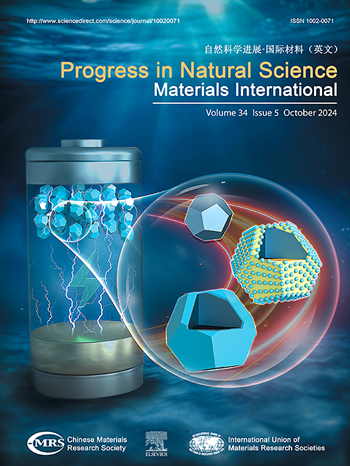通过机器学习优化多孔结构,促进太阳能热化学燃料生产
IF 4.8
2区 材料科学
Q2 MATERIALS SCIENCE, MULTIDISCIPLINARY
Progress in Natural Science: Materials International
Pub Date : 2024-10-01
DOI:10.1016/j.pnsc.2024.07.024
引用次数: 0
摘要
多孔反应物是太阳能热化学反应的关键成分,对太阳能转换和燃料生产性能有重大影响。三重周期性最小表面(TPMS)结构具有分析表达式和可预测的结构-性能关系,可促进此类结构的设计和优化。本研究提出了一种机器学习辅助框架,用于优化 TPMS 结构,以提高反应效率、增加燃料产量并降低温度梯度。为了降低传统高通量优化的计算成本,我们使用神经网络回归模型根据输入特征进行性能预测。训练数据集是使用一个三维多物理场模型生成的,该模型用于考虑流体流动、传热和传质以及化学反应的聚光太阳能驱动的热化学还原。三维模型对均匀结构和梯度结构进行了初步评估,结果表明 c 和 ω 的梯度设计对提高性能十分必要。此外,在我们提出的优化框架下,我们发现参数 c1 = c2 = 0.5(c 中均匀)和 ω1 = 0.2, ω2 = 0.8(ω 中梯度)的结构实现了最高的相对效率(fchem/fchem,ref)1.58,相对燃料产量(Δδ/Δδref)7.94,以及最大相对温度梯度(dT/dy)/(dT/dy)ref 0.26。对动力学特性(即体积扩散和表面交换系数)的研究还表明,与快速动力学材料相比,对于慢速动力学材料,c 和 ω 的设计空间非常有限。我们的框架适用于不同的多孔结构和操作条件,是筛选太阳能热化学应用多孔结构的多功能工具。这项工作有望推动高效太阳能燃料生产系统的开发和可再生能源技术的可扩展工业应用。本文章由计算机程序翻译,如有差异,请以英文原文为准。
Optimization of porous structures via machine learning for solar thermochemical fuel production
Porous reactant is the key component in solar thermochemical reactions, significantly affecting the solar energy conversion and fuel production performance. Triply periodic minimal surface (TPMS) structures, with analytical expressions and predictable structure-property relationships, can facilitate the design and optimization of such structures. This work proposes a machine learning-assisted framework to optimize TPMS structures for enhanced reaction efficiency, increased fuel production, and reduced temperature gradients. To mitigate the computational cost of conventional high-throughput optimization, neural network regression models were used to for performance prediction based on input features. The training dataset was generated using a three-dimensional multiphysics model for the thermochemical reduction driven by concentrated solar energy considering fluid flow, heat and mass transfer, and chemical reacions. Both uniform and gradient structures were initially assessed by the three-dimensional model showing gradient design in c and ω were necessary for performance enhancement. Further, with our proposed optimization framework, we found that structures with parameters c1 = c2 = 0.5 (uniform in c ) and ω1 = 0.2, ω2 = 0.8 (gradient in ω) achieved the highest relative efficiency (fchem/fchem,ref) of 1.58, a relative fuel production (Δδ/Δδref) of 7.94, and a max relative temperature gradient (dT/dy)/(dT/dy)ref of 0.26. Kinetic properties, i.e., bulk diffusion and surface exchange coefficient, were also studied showing that for materilas with slow kinetics, the design space in terms of c and ω were highly limited compared to fast kinetics materials. Our framework is adaptable to diverse porous structures and operational conditions, making it a versatile tool for screening porous structures for solar thermochemical applications. This work has the potential to advance the development of efficient solar fuel production systems and scalable industrial applications in renewable energy technologies.
求助全文
通过发布文献求助,成功后即可免费获取论文全文。
去求助
来源期刊
CiteScore
8.60
自引率
2.10%
发文量
2812
审稿时长
49 days
期刊介绍:
Progress in Natural Science: Materials International provides scientists and engineers throughout the world with a central vehicle for the exchange and dissemination of basic theoretical studies and applied research of advanced materials. The emphasis is placed on original research, both analytical and experimental, which is of permanent interest to engineers and scientists, covering all aspects of new materials and technologies, such as, energy and environmental materials; advanced structural materials; advanced transportation materials, functional and electronic materials; nano-scale and amorphous materials; health and biological materials; materials modeling and simulation; materials characterization; and so on. The latest research achievements and innovative papers in basic theoretical studies and applied research of material science will be carefully selected and promptly reported. Thus, the aim of this Journal is to serve the global materials science and technology community with the latest research findings.
As a service to readers, an international bibliography of recent publications in advanced materials is published bimonthly.

 求助内容:
求助内容: 应助结果提醒方式:
应助结果提醒方式:


